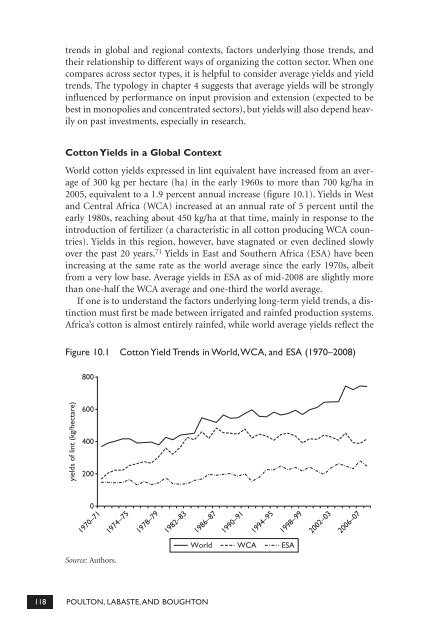Organization and Performance of Cotton Sectors in Africa ... - infoDev
Organization and Performance of Cotton Sectors in Africa ... - infoDev
Organization and Performance of Cotton Sectors in Africa ... - infoDev
You also want an ePaper? Increase the reach of your titles
YUMPU automatically turns print PDFs into web optimized ePapers that Google loves.
trends <strong>in</strong> global <strong>and</strong> regional contexts, factors underly<strong>in</strong>g those trends, <strong>and</strong>their relationship to different ways <strong>of</strong> organiz<strong>in</strong>g the cotton sector. When onecompares across sector types, it is helpful to consider average yields <strong>and</strong> yieldtrends. The typology <strong>in</strong> chapter 4 suggests that average yields will be strongly<strong>in</strong>fluenced by performance on <strong>in</strong>put provision <strong>and</strong> extension (expected to bebest <strong>in</strong> monopolies <strong>and</strong> concentrated sectors), but yields will also depend heavilyon past <strong>in</strong>vestments, especially <strong>in</strong> research.<strong>Cotton</strong> Yields <strong>in</strong> a Global ContextWorld cotton yields expressed <strong>in</strong> l<strong>in</strong>t equivalent have <strong>in</strong>creased from an average<strong>of</strong> 300 kg per hectare (ha) <strong>in</strong> the early 1960s to more than 700 kg/ha <strong>in</strong>2005, equivalent to a 1.9 percent annual <strong>in</strong>crease (figure 10.1). Yields <strong>in</strong> West<strong>and</strong> Central <strong>Africa</strong> (WCA) <strong>in</strong>creased at an annual rate <strong>of</strong> 5 percent until theearly 1980s, reach<strong>in</strong>g about 450 kg/ha at that time, ma<strong>in</strong>ly <strong>in</strong> response to the<strong>in</strong>troduction <strong>of</strong> fertilizer (a characteristic <strong>in</strong> all cotton produc<strong>in</strong>g WCA countries).Yields <strong>in</strong> this region, however, have stagnated or even decl<strong>in</strong>ed slowlyover the past 20 years. 71 Yields <strong>in</strong> East <strong>and</strong> Southern <strong>Africa</strong> (ESA) have been<strong>in</strong>creas<strong>in</strong>g at the same rate as the world average s<strong>in</strong>ce the early 1970s, albeitfrom a very low base. Average yields <strong>in</strong> ESA as <strong>of</strong> mid-2008 are slightly morethan one-half the WCA average <strong>and</strong> one-third the world average.If one is to underst<strong>and</strong> the factors underly<strong>in</strong>g long-term yield trends, a dist<strong>in</strong>ctionmust first be made between irrigated <strong>and</strong> ra<strong>in</strong>fed production systems.<strong>Africa</strong>’s cotton is almost entirely ra<strong>in</strong>fed, while world average yields reflect theFigure 10.1 <strong>Cotton</strong> Yield Trends <strong>in</strong> World, WCA, <strong>and</strong> ESA (1970–2008)800yields <strong>of</strong> l<strong>in</strong>t (kg/hectare)60040020001970–711974–751978–791982–831986–871990–911994–951998–992002–032006–07World WCA ESASource: Authors.118 POULTON, LABASTE, AND BOUGHTON
















